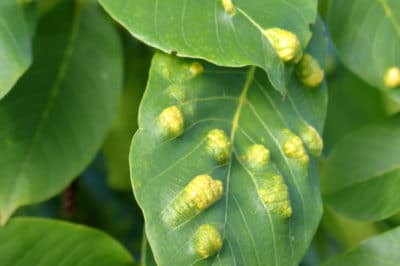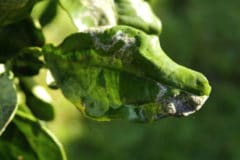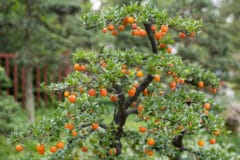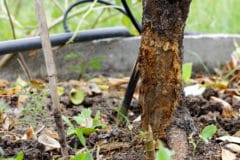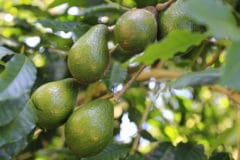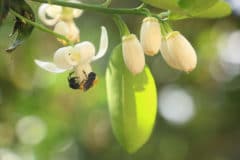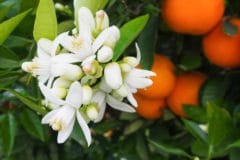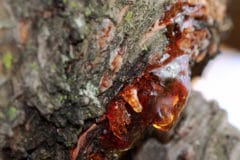Citrus Greening
Also known as huanglongbing or yellow dragon disease, bacterial citrus greening disease is the biggest threat facing orange trees growing today. Its symptoms include:
- Yellow-mottled leaves and shoots
- Leathery leaves with raised, corky veins
- Undersized fruit that remains green at the ends
- Pulp full of bitter juice and discolored, aborted seeds.
Tiny, tan and brown Asian citrus psyllids inject the citrus greening bacteria into orange trees when they feed on their leaves.
Dealing with Citrus Greening Disease
A cure for this disease has yet to be discovered. Once stricken, your orange tree will eventually weaken and die. Removal is the only choice if you want to keep it from spreading the disease to other trees.
If your tree is still healthy, consider constructing a “house” of fine mesh screening around it to keep the psyllids out.
Phytophthora Infections
The Phytophthora fungus strikes orange trees through wounded bark or overwatered roots. Infected trunks develop water-soaked bark lesions that often weep gum. As the bark dies, it pulls away in vertical strips.
Infected roots have soft, discolored water-soaked surfaces. Their outer layer peels away, exposing the thread-fine cylinders.
Other symptoms include yellowing leaves, dying shoots and decreased crops of undersized oranges. If the roots are infected, the trees’ growth slows or stops. Branches wilt due to inadequate water and nutrient uptake.
Dealing with Phytophthora Fungus
To discourage bark infections:
- Plant your tree in a wind-sheltered spot and giving it frost protection as needed.
- Keep the trunk dry.
- Keep piled soil or mulch away from the trunk.
- Remove any branches touching the soil.
- Scrape away dark, diseased bark.
- Avoid the trunk when mowing or weed whacking.
To keep root infections at bay, plant your orange tree in very well draining soil. Water it slowly and deeply only when the top 6 inches of soil are dry. If you see signs of severe root damage, remove the tree.
Expert gardener’s tip: Before replanting in the same spot, treat the soil with the organic fungicide Bacillus subtilis (strain QST713) at the manufacturer’s recommended rate.
